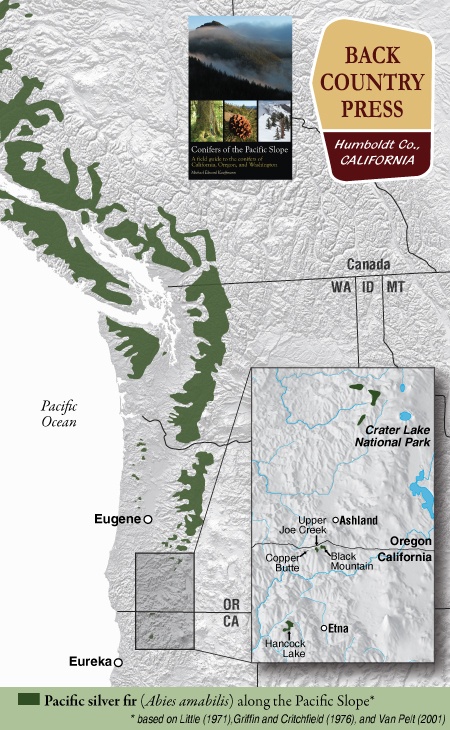BLURB FROM THE TALK: Humboldt County educator, author, and ecologist Michael Kauffmann has been tracking the status and distribution of Klamath Mountain conifers for over 15 years and his book, Conifer Country, if the definitive field guide to the region. Michael will take us from mountain summits to coastal river valleys and provide updates on the status and distribution of many of these charismatic conifers based on field work in the summer of 2019 with the California Native Plant Society Vegetation Team. He will also share photos and stories about exciting plants from the region.
Pacific Silver Fir in California
Part 2: Marble Mountain Wilderness
Read Part 1
In conjunction with the Klamath National Forest and the California Native Plant Society Vegetation Team, I completed a mapping and inventory project for Pacific silver fir (Abies amabilis) in California. The first part of this project was along the Siskiyou Crest, near the Oregon-California border. This post is about the populations in the Marble Mountain Wilderness.
In 2016 I embarked on a mapping and inventory project for yellow-cedar (Callitropsis nootkatensis) in California. At the time, I called yellow-cedar California’s rarest conifer. In 2019, new discoveries on the north slopes of Copper Butte and Preston Peak brought the total hectares of yellow-cedar in California to ~21 hectares. With this new data, and that collected in this project, we now know Abies amabilis is California’s rarest conifer*! See table below for stand data summary.
*This excludes the neoendemic California cypresses.
Continue reading “Pacific Silver Fir in California”Pacific Silver Fir in California
Part 1: The Siskiyou Crest

In conjunction with the Klamath National Forest and the California Native Plant Society Vegetation Team, I began a mapping and inventory project for Pacific silver fir (Abies amabilis) in California. The first part of this project was along the Siskiyou Crest, near the Oregon-California border. Later this summer I will visit the other population in the Marble Mountain Wilderness.
Pacific silver fir in California can easily be overlooked because of its similarity to white fir (Abies concolor). Upon close inspection (and by going to specific locations) the differences will become apparent. Silver fir is identifiable in the hand because it has the most distinct and exuberant stomatal bloom of any regional tree. Like grand fir (and regionally white fir) the tips of the needles are notched. The needles splay from the branch on only one side often in a perfect arrays, fanning out in a semi-circular manner. The needles occasionally twist in this array, thus offering distinct silver flashes of the stomatal bloom on the undersides—a brilliant contrast to the dark-green upper surfaces. This is also what sets it apart from white fir, with a duller stomatal bloom. As with other Abies, the smell of crushed needles emits a resinous “pine scent.” The bark is distinct, forming long, narrow, rectangular blocking patterns that seem to melt off the trunks in silvery chunks with subtle reddish hues in the furrows. At a distance, larger trees are gradually tapered, similar to Shasta fir (Abies magnifica var. shastensis). It is an inimitable and rare experience to spend time with this beauty in the Klamath Mountains
Continue reading “Pacific Silver Fir in California”

